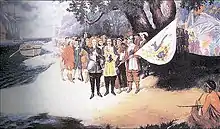Mississippi Gulf Coast
The Mississippi Gulf Coast, also known as the Mississippi Gulf Coast region, Coastal Mississippi, or simply The Coast, is the area of southern Mississippi along the Mississippi Sound along the Gulf of Mexico.
Mississippi Gulf Coast | |
|---|---|
Coastline | |
 Clockwise from top: Ingalls Shipbuilding, the Biloxi Beach, the Dantzler House, Beauvoir, the Beau Rivage Casino, the Bay Saint Louis Bridge, the USM Gulf Park, the Hard Rock Casino Biloxi, and Saint John's Epispocal Church | |
| Nickname(s): The Coast | |
 Location of coastal counties in Mississippi. Red counties are included in Gulfport-Biloxi-Pascagoula MSA. Blue county is included in the geographical area below the 31st parallel. | |
| Area | |
| • Total | 2,764,358 acres (1,118,696 ha) |
| Dimensions | |
| • Length | 80 mi (130 km) |
| • Width | 55 mi (89 km) |
| Population | |
| • Total | 370,702 |
| • Estimate (2018) | 397,261 |
| • Density | 86/sq mi (33/km2) |
| Time zone | UTC-6 (CST) |
| • Summer (DST) | UTC-5 (CDT) |
| Area code(s) | 228 |
| Website | www |
Geography
At the state's creation, Hancock and Jackson were the only two counties to make up this region. However, before the end of the first centennial, subdivisions in the counties lead to the formation of Harrison County, as well as the pineywoods counties of Pearl River, Stone and George.[2]
Cities
The Mississippi Gulf Coast consists of many cities that lie directly on the Mississippi Sound. The U. S. Census Bureau divided the Metropolitan Statistical Area (MSA) for the Mississippi Gulf Coast in 2003, which previously had been the three coastal counties, into two MSAs that included two additional counties. Cities in the new Metropolitan Statistical Area include the original French settlements in Biloxi and Ocean Springs, as well as Waveland, Bay St. Louis, Diamondhead, Pass Christian, Long Beach, Gulfport, D'Iberville, Gautier, Pascagoula, and Moss Point.
History
Early History
The Biloxi people lived in the region at least as early as 1699.
Colonial History

In 1699, Pierre Le Moyne d'Iberville arrived to establish a colony near the mouth of the Mississippi River. He landed on the Ship Island, and three days later, arrived on the Mississippi Gulf Coast, establishing a colony and building Fort Maurepas, which served as the first capital of French Louisiana. The fort became a base of operations to continue exploring the area.[4]
The French settlers found the area to be difficult to maintain a settlement. According to Bunn & Williams (2007), factors such as death of crops, lack of fresh water, lack of discipline, and illness led to difficulty in maintaining the colonization of the area. Furthermore, due to political concerns, the capital of French Louisiana was moved to Mobile in 1701; the fort was abandoned by 1702. Despite a temporary move of the capital to Biloxi during the construction of New Orleans, previous failures kept the area from playing a further role in French colonization efforts in the region.[4]
Statehood and Antebellum Period
When Mississippi entered the Union in 1817, the majority of the population lived in Northern parts of the state. At statehood, the population of the coast comprised 2.5% of the state's total. Likewise, the Census lists only 586 of the state's 30,061 slaves as living on the Mississippi Gulf Coast.[2] After statehood, the coastal regions remained a frontier, with cultural influences coming from the Mediterranean area. According to Kenneth P'Pool, deputy historic preservation officer at MDAH, "The Coast's situation along ... the Gulf of Mexico — both facilitated the region's ethnic diversity and maintained its ties to the rest of the world much more easily than was possible for other regions of [Mississippi]."[2]
Civil War
Fort Massachusetts, on Ship Island, was seized during the American Civil War.
Twentieth century
In the 20th century, Keesler Air Force Base brought development to the region. Hurricane Camille on August 17, 1969, and Hurricane Katrina on August 29, 2005 caused historic destruction to the Gulf Coast.
Education
As of May 2019, there are 122 K-12 schools spread across 15 school districts, which serve students in the Mississippi Gulf Coast region. In addition, the Mississippi Gulf Coast Community College offers associate degree and career programs.
Notable people
- Walter Inglis Anderson, painter, writer, and naturalist
- Frederick Barthelme, novelist
- Varina Davis, First Lady of the Confederate States of America
- Prentiss Ingraham, Confederate soldier and writer
- Jack Nelson, Pulitzer Prize winning journalist of the Civil Rights era
- George E. Ohr, ceramic artist
- Eugene Antonio Marino, Archbishop emeritus of Atlanta
- Fannie C. Williams, educator
- William Woodward, artist
See also
- Land Trust for the Mississippi Coastal Plain
- Gulf Coast of the United States
Notes
- Adding up the individual areas of Pearl River, Stone, George, Jackson, Harrison, and Hancock counties, the six counties below the 31st parallel mentioned in the reference from the Sun Herald, and converting from square miles to acres provides this result.
- Enter school district name into search box.
- The reference lists individual schools at the bottom of each school district's result page.
References
- "County Explorer". National Association of Counties. National Association of Counties. Retrieved 10 May 2019.
- Bergeron, Kat (March 30, 2017). "The Coast from 1817 to 1917: From frontier to tourist destination". SunHearld. Retrieved 2019-04-13.
- "Gulfport-Biloxi-Pascagoula Metro: Annual Estimates of the Resident Population: April 1, 2010 to July 1, 2018 more information 2018 Population Estimates". US Census Bureau. US Census Bureau. Archived from the original on 14 February 2020. Retrieved 10 May 2019.
- Bunn, J. Michael; Williams, Clay (September 2007). "A Failed Enterprise: The French Colonial Period in Mississippi | Mississippi History Now". www.mshistorynow.mdah.ms.gov. Mississippi Department of Archives and History. Retrieved 2019-04-13.
- "Mississippi Succeeds Report Card". Mississippi Succeeds Report Card. Mississippi Department of Education. Retrieved 10 May 2019.
.svg.png.webp)